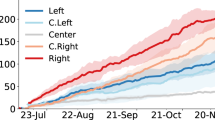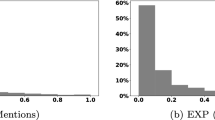Abstract
Spread of news and misinformation on social networks have been a topic of extensive study in the recent years. There are concerns about the possibility of ongoing information operations, which has lead to studies on a wide scope including the truthfulness of content and the participation of social bots in the process. Studying how online entities of journalists is embedded in the Twitter network is crucial for understanding the core of this problem, since they hold a valuable broadcast platform in informing the public. In this work, we collected over 290,000 accounts that self-identify as a journalist or a reporter and analyzed their professional and follower networks on the platform. Twitter follower composition of journalists reflect their potential audiences and who disseminates their messages further on the network. It is essential for a journalist to reach a broad, organic readership as opposed to a following of bots and bot-assisted accounts. We looked at the followers of journalists for an analysis of the composition and evolution of their audiences, particularly looking out for social bot involvement. We found the trends for verified and non-verified accounts to be opposite of each other; among verified accounts bot follower tend to target more popular ones, whereas unverified accounts have a higher fraction of bot followers early on when they have fewer followers, possibly indicating attempts at boosting apparent popularity artificially. Outcomes of this research emphasize the importance of editorial oversight and that the prestige of journalists should not be confused with their apparent popularity online.








Similar content being viewed by others
Notes
References
Vis, F. (2013). Twitter as a reporting tool for breaking news: Journalists tweeting the 2011 UK riots. Digital Journalism, 1(1), 27.
Hu, M., Liu, S., Wei, F., Wu, Y., Stasko, J., & Ma, K.L. (2012). Breaking news on twitter. In Proceedings of the SIGCHI conference on human factors in computing systems (ACM), pp. 2751–2754.
Bruns, A., Highfield, T., & Lind, R. A. (2012). Produsing theory in a digital world: The intersection of audiences and production in contemporary theory. Twitter, and Breaking News: The Produsage of Citizen Journalism, 80(2012), 15.
Zubiaga, A., Heravi, B., An, J., & Kwak, H. (2019). Social media mining for journalism. Online Information Review, 43(1), 2.
Morris, M., & Ogan, C. (1996). The Internet as mass medium. Journal of Communication, 46(1), 39.
Murthy, D. (2011). Twitter: Microphone for the masses? Media, Culture and Society, 33(5), 779.
Kwak, H., Lee, C., Park, H., & Moon, S. (2010). What is Twitter, a social network or a news media? In Proceedings of the 19th international conference on World wide web (AcM), pp. 591–600
Artwick, C. G. (2013). Reporters on Twitter: Product or service? Digital Journalism, 1(2), 212.
Wasike, B.S. (2013). Framing news in 140 characters: how social media editors frame the news and interact with audiences via Twitter. Global Media Journal: Canadian Edition 6(1).
Armstrong, C. L., & Gao, F. (2010). Now tweet this: How news organizations use Twitter. Electronic News, 4(4), 218.
Bruns, A. (2012). Journalists and Twitter: How Australian news organisations adapt to a new medium. Media International Australia, 144(1), 97.
Brems, C., Temmerman, M., Graham, T., & Broersma, M. (2017). Personal Branding on Twitter: How employed and freelance journalists stage themselves on social media. Digital Journalism, 5(4), 443.
Hanusch, F., & Bruns, A. (2017). Journalistic branding on Twitter: A representative study of Australian journalists’ profile descriptions. Digital Journalism, 5(1), 26.
Molyneux, L., Holton, A., & Lewis, S. C. (2018). How journalists engage in branding on Twitter: Individual, organizational, and institutional levels. Information, Communication and Society, 21(10), 1386.
Riffkin, R. (2015). Americans’ trust in media remains at historical low, Gallup, September 28
Gonçalves, B., Perra, N., & Vespignani, A. (2011). Modeling users’ activity on twitter networks: Validation of dunbar’s number. PloS One, 6(8), e22656.
Mullin, B. (2015). Report: Journalists are largest, most active verified group on Twitter. Poynter, 26. https://www.poynter.org/reporting-editing/2015/report-journalists-are-largest-most-active-group-on-twitter/.
Varol, O., Ferrara, E., Davis, C.A., Menczer, F., Flammini, A. (2017). Online human-bot interactions: Detection, estimation, and characterization. In Proc. Intl. AAAI Conf. on Web and Social Media (ICWSM)
Ferrara, E., Varol, O., Davis, C., Menczer, F., & Flammini, A. (2016). The rise of social bots. Communications of the ACM, 59(7), 96.
Davis, C.A., Varol, O., Ferrara, E., Flammini, A., & Menczer, F. (2016). BotOrNot: A system to evaluate social bots. In In Proc. 25th intl. conf. companion on World Wide Web, pp. 273–274
Wojcik, S., Messing, S., Smith, A., Rainie, L., & Hitlin, P. (2018). Bots in the Twittersphere, Pew Research Center. Retrieved May, 22, 2018.
Borge-Holthoefer, J., Rivero, A., García, I., Cauhé, E., Ferrer, A., Ferrer, D., et al. (2011). Structural and dynamical patterns on online social networks: The Spanish May 15th movement as a case study. PloS One, 6(8), e23883.
Choudhary, A., Hendrix, W., Lee, K., Palsetia, D., & Liao, W. K. (2012). Social media evolution of the Egyptian revolution. Communications of the ACM, 55(5), 74.
Conover, M. D., Ferrara, E., Menczer, F., & Flammini, A. (2013). The digital evolution of occupy wall street. PloS One, 8(5), e64679.
Varol, O., Ferrara, E., Ogan, C.L., Menczer, F. & Flammini, A. (2014). Evolution of online user behavior during a social upheaval. In Proceedings of the 2014 ACM conference on web science (ACM), pp. 81–90.
Ahmad, A. N. (2010). Is Twitter a useful tool for journalists? Journal of Media Practice, 11(2), 145.
Bagdouri, M., Oard, D.W. (2015). Profession-based person search in microblogs: using seed sets to find journalists. In Proceedings of the 24th ACM international on conference on information and knowledge management (ACM), pp. 593–602
Russell, F. M., Hendricks, M. A., Choi, H., & Stephens, E. C. (2015). Who sets the news agenda on Twitter? Journalists’ posts during the 2013 US government shutdown. Digital Journalism, 3(6), 925.
Molyneux, L. (2015). What journalists retweet: Opinion, humor, and brand development on Twitter. Journalism, 16(7), 920.
Sheffer, M. L., & Schultz, B. (2010). Paradigm shift or passing fad? Twitter and sports journalism. International Journal of Sport Communication, 3(4), 472.
Canter, L. (2015). Personalised tweeting: The emerging practices of journalists on Twitter. Digital Journalism, 3(6), 888.
Lee, N. Y., & Kim, Y. (2014). The spiral of silence and journalists’ outspokenness on Twitter. Asian Journal of Communication, 24(3), 262.
Parmelee, J. H. (2013). Political journalists and Twitter: Influences on norms and practices. Journal of Media Practice, 14(4), 291.
Lawrence, R. G., Molyneux, L., Coddington, M., & Holton, A. (2014). Tweeting Conventions: Political journalists’ use of Twitter to cover the 2012 presidential campaign. Journalism Studies, 15(6), 789.
Lasorsa, D. (2012). Transparency and other journalistic norms on Twitter: The role of gender. Journalism Studies, 13(3), 402.
Jürgens, P., Jungherr, A., & Schoen, H. (2011). Small worlds with a difference: New gatekeepers and the filtering of political information on Twitter. In Proceedings of the 3rd international web science conference (ACM), p. 21
Gil de Zúñiga, H., Diehl, T., & Ardèvol-Abreu, A. (2018). When citizens and journalists interact on Twitter: Expectations of journalists’ performance on social media and perceptions of media bias. Journalism Studies, 19(2), 227.
Rogstad, I. D. (2014). Political News Journalists in Social Media: Transforming political reporters into political pundits? Journalism Practice, 8(6), 688.
Broussard, M. (2015). Artificial intelligence for investigative reporting: Using an expert system to enhance journalists’ ability to discover original public affairs stories. Digital Journalism, 3(6), 814.
Carlson, M. (2015). The robotic reporter: Automated journalism and the redefinition of labor, compositional forms, and journalistic authority. Digital Journalism, 3(3), 416.
Montal, T., & Reich, Z. (2017). I, robot. You, journalist. Who is the author? Authorship, bylines and full disclosure in automated journalism. Digital Journalism, 5(7), 829.
Lewis, S. C., Sanders, A. K., & Carmody, C. (2019). Libel by algorithm? Automated journalism and the threat of legal liability. Journalism and Mass Communication Quarterly, 96(1), 60.
Mitchell, A., & Holcomb, J. (2015). State of the news media 2015. Pew Research Center, 29
Ju, A., Jeong, S. H., & Chyi, H. I. (2014). Will social media save newspapers? Examining the effectiveness of Facebook and Twitter as news platforms. Journalism Practice, 8(1), 1.
Lokot, T., & Diakopoulos, N. (2016). News bots: Automating news and information dissemination on Twitter. Digital Journalism, 4(6), 682.
Badawy, A., Addawood, A., Lerman, K., & Ferrara, E. (2018). Characterizing the 2016 Russian IRA Influence Campaign, arXiv preprint arXiv:1812.01997
Shao, C., Ciampaglia, G. L., Varol, O., Yang, K. C., Flammini, A., & Menczer, F. (2018). The spread of low-credibility content by social bots. Nature Communications, 9(1), 4787.
Varol, O., & Uluturk, I. (2018). Deception strategies and threats for online discussions. First Monday, 22(5)
Dutt, R., Deb, A., & Ferrara, E. (2018). Senator, We Sell Ads: Analysis of the 2016 Russian Facebook Ads Campaign. In International conference on intelligent information technologies (Springer), pp. 151–168
Vosoughi, S., Roy, D., & Aral, S. (2018). The spread of true and false news online. Science, 359(6380), 1146.
Schifferes, S., Newman, N., Thurman, N., Corney, D., Göker, A., & Martin, C. (2014). Identifying and verifying news through social media: Developing a user-centred tool for professional journalists. Digital Journalism, 2(3), 406.
Coddington, M., Molyneux, L., & Lawrence, R. G. (2014). Fact checking the campaign: How political reporters use Twitter to set the record straight (or not). The International Journal of Press/Politics, 19(4), 391.
Brandtzaeg, P. B., Følstad, A., & Chaparro Domínguez, M. Á. (2018). How journalists and social media users perceive online fact-checking and verification services. Journalism Practice, 12(9), 1109.
Yang, K. C., Varol, O., Davis, C. A., Ferrara, E., Flammini, A., & Menczer, F. (2019). Arming the public with artificial intelligence to counter social bots. Human Behavior and Emerging Technologies,. https://doi.org/10.1002/hbe2.115.
Stocking, G., & Sumida, N. (2018). Social media bots draw public’s attention and concern. Washington, DC: Pew Research Center. https://www.journalism.org/2018/10/15/social-media-bots-draw-publics-attention-and-concern/.
Shao, C., Ciampaglia, G.L., Flammini, A., & Menczer, F. (2016). Hoaxy: A platform for tracking online misinformation, In Proceedings of the 25th international conference companion on world wide web (International World Wide Web Conferences Steering Committee), pp. 745–750.
Davis, C. A., Ciampaglia, G. L., Aiello, L. M., Chung, K., Conover, M. D., Ferrara, E., et al. (2016). OSoMe: The IUNI observatory on social media. PeerJ Computer Science, 2, e87.
Author information
Authors and Affiliations
Corresponding author
Ethics declarations
Conflict of interest
On behalf of all authors, the corresponding author states that there is no conflict of interest.
Additional information
Publisher's Note
Springer Nature remains neutral with regard to jurisdictional claims in published maps and institutional affiliations.
Rights and permissions
About this article
Cite this article
Varol, O., Uluturk, I. Journalists on Twitter: self-branding, audiences, and involvement of bots. J Comput Soc Sc 3, 83–101 (2020). https://doi.org/10.1007/s42001-019-00056-6
Received:
Accepted:
Published:
Issue Date:
DOI: https://doi.org/10.1007/s42001-019-00056-6




